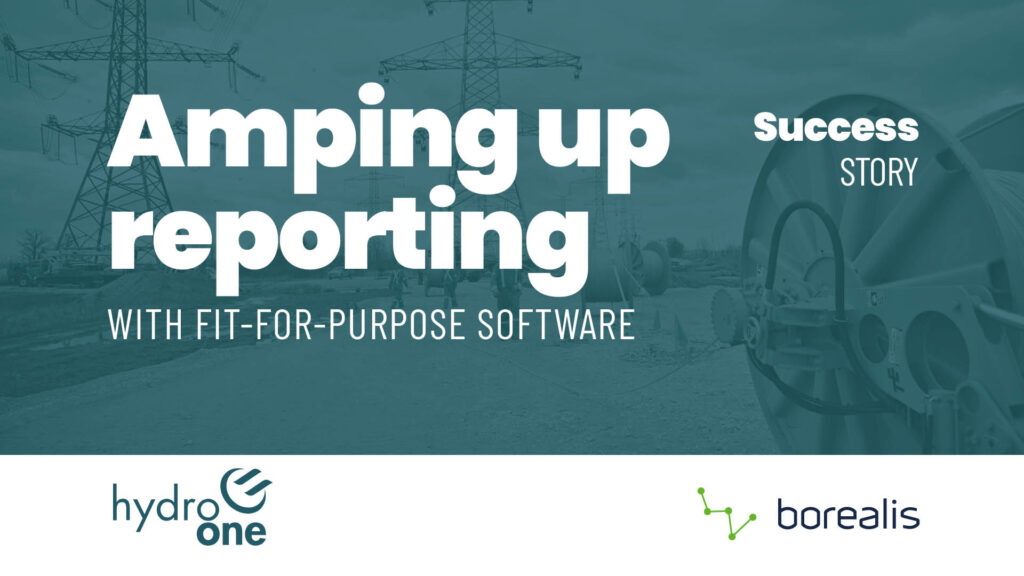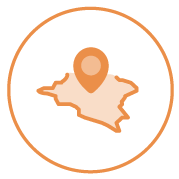Amping up reporting
with fit-for-purpose software
Company overview
Hydro One is the largest electricity transmission and distribution service provider in Ontario, Canada. They distribute electricity across Ontario to nearly 1.5 million customers (approximately 26% of the total number of customers in Ontario). Hydro One owns and operates transmission assets on 23 First Nations reserves and provides distribution services directly to 88 First Nations communities.
Using Borealis since: 2018 (5+ years)
Teams Using Borealis: Indigenous Relations, Environmental Programs & Approvals, Customer Care, Community Relations
Users: 120+
Requirements
In order to deliver service to their clients, Hydro One needs to install and maintain a series of transmission lines.
As part of the permitting process, the government of Ontario requires that organizations prepare Environmental Assessments (EAs) to ensure that they have considered potential environmental impacts before construction begins.
Additionally, since these projects affect Indigenous lands, the organization has a responsibility to consult with the communities that would be impacted.
The Indigenous Relations team must prepare a record of consultation to prove that rights holders have been properly informed about a project, their concerns have been heard, and that all parties have come to a satisfactory agreement. This record must be accompanied by supporting documentation.
Beyond these legal obligations, Hydro One’s Values and Guiding Principles underscore their pledge to partner with Indigenous communities transparently and respectfully, and to advance meaningful economic Reconciliation. and that all parties have come to a satisfactory agreement. This record must be accompanied by supporting documentation.
“Hydro One is committed to working with Indigenous peoples in a spirit of cooperation and shared responsibility. We acknowledge that Indigenous peoples have unique historic and cultural relationships with their land and a unique knowledge of the natural environment. Forging meaningful relationships with Indigenous peoples based upon trust, confidence, and accountability is vital to achieving our corporate objectives.’’
Hydro One,
Indigenous Relations Policy
Main challenges
- Reporting: With no single source of truth, finding complete and accurate information took considerable time and effort; reporting was incredibly time-consuming – not to mention stressful.
- Respecting commitments: There was no effective way to track commitments and ensure that promises were kept.
- Collaboration: Because different versions of project spreadsheets were circulating, it was very difficult to work collaboratively with other teams or maintain a global view of the project.
- Consistent approach: Teams were spread across three different regions in the province, and processes and terminology differed from one to the next.
With three major Environmental Assessments coming due, the organization recognized the need to manage data more efficiently and prioritized finding the right tool to support their work.
Solution
Hydro One decided to implement a single, shared system to centralize and structure project data and ensure that all teams had access to complete, up-to-date information. They evaluated several options, and ultimately chose Borealis Stakeholder Engagement software.
Borealis had the functionality we were looking for. We have an important obligation to record our consultation; the software excels at helping us capture our consultation efforts and then allows us to slice and dice them. Also, when we’re working with the same community on a new project, we’re able to leverage information that’s already in our database and build on that. We chose Borealis based on cost and functionality, but also security. Meeting our security requirements was a big factor.
Renee Pettigrew,
Environmental Programs & Approvals, Hydro One
Key benefits
Since implementing Borealis:
- Data is centralized in a single location. Everyone on the team has access to complete, accurate, up-to-date information. This improves collaboration and helps teams make informed decisions.
- Interactions are well documented, accessible, and easy to report on, which results in greater efficiency and less stress.
- Commitments are carefully tracked and delivered, ensuring accountability.
- Teams work more efficiently, saving time and money.
- Processes have been streamlined around the tool, allowing teams to work more strategically.
To me, the main benefit of Borealis is that it gives us a central repository where anybody from the various lines of business – whether that’s Environment, Project Delivery, Indigenous Relations, Community Relations – can go in and see exactly what consultation work has been done: who we’ve been consulting with, what are the outcomes of that, and then pull reports from the same source.
Paul Dalmazzi,
Environmental Planner, Hydro One
Using Borealis
Creating a solid record of consultation
Hydro One uses Borealis to capture and document their consultation work, including feedback and concerns from affected communities.
A record of consultation is one of the main elements required in the Environmental Assessment process. The record must be thorough and well documented to ensure that it can stand up to scrutiny. For example, if the adequacy of their consultation is challenged, Hydro One can use the interactions documented in Borealis to show how they have communicated their plans to the public, to appropriate agencies, and to Indigenous communities. Borealis also helps them plan these engagements and manage the supporting documentation they need to secure project approvals.
That was what we initially brought into the system. But other programs, even projects that might not require an EA, are starting to see the benefits of a system like Borealis.
Paul Dalmazzi
Environmental Planner, Hydro One
Building better relationships with communities
In addition to helping Hydro One meet reporting requirements, carefully documenting their consultation work helps the engagement team build trust with Indigenous rights holders. It’s clear that everyone on the team is informed about issues that are important to the community, and that they are listening, documenting, and addressing the feedback they receive. This demonstrates respect for the community and shows them that Hydro One takes their concerns seriously.
Borealis has been incredibly helpful in elevating our relationships with stakeholders and rights holders. It has been rolled into our Indigenous Relations strategy. One of the four pillars of the strategy is accountability, and Borealis is the tool that we use to keep ourselves accountable in our work.
Erika Dawson,
Senior Advisor, Indigenous Relations, Hydro One
Improving visibility between teams
Centralizing project data helps everyone understand how other teams are interacting with the communities, and plan their engagements accordingly. For example, when Erika needs to consult with a specific group of rights holders, she can see all of her colleagues’ correspondence with those individuals, whether it pertains to Indigenous consultation, environmental correspondence, or customer care.
Borealis helps me plan my engagements more effectively, because I can see how other lines of business are communicating with the communities. It helps me stay up to date with what the project team is working on, and vice versa. Our customer care team also works with Borealis, and that means I can see if any of the communities. I’m engaging with have raised customer care issues. Being aware of all these different interactions has streamlined our approach to working with communities. Having insight into all those communications and tracking the data is really helpful.
Erika Dawson,
Senior Advisor, Indigenous Relations, Hydro One
Ensuring that teams follow up on commitments
Because accountability is so important to maintaining good relationships, Hydro One wants to ensure that they always follow through on commitments. Borealis makes it easy to track commitments and schedule tasks and notifications to ensure timely follow-ups.
Our relationship work is based on trust, which means keeping our commitments. Prior to using Borealis we weren’t able to track those effectively, so we weren’t always following through. Borealis is a great tool that helps make sure we always follow up on our commitments and that they are tracked over time.
Erika Dawson,
Senior Advisor, Indigenous Relations, Hydro One
Monitoring and measuring progress
Tracking these events under an Engagement Plan helps teams evaluate the outcomes of these efforts – for example, they can monitor attendance to evaluate interest. Did more people attend the first open house or the third? Is the number of participants fairly consistent, or is it increasing or decreasing? Are the same people are attending each event, or is the audience different every time? What issues are raised, and how often do they come up? With these insights, teams can adjust their approach as needed.
Communicating efficiently with groups of stakeholders
Public engagement is one of the main requirements for the Environmental Assessment process. From time to time, Hydro One’s Community Relations team needs to send a message to a lot of recipients at once, such as people within a designated study area, or along a specific corridor. To simplify the process, they use the Smart Communications feature in Borealis to send customized letters and emails to the people involved.
These messages are automatically saved in the corresponding stakeholder records. Smart Communications help the team reach the right people quickly and efficiently, rather than reaching out to each individual separately. When these messages are sent by email, the team can easily monitor which emails have been opened, and how many times. This feedback helps the Community Relations team gauge the success of their outreach efforts.
Borealis automates some of the tasks that were taking planners a long time to accomplish, like mail merges and sending out mailings. When I joined the company, we had an extra consultant just to help us with those pieces, and we knew that Borealis could help with this.
Renee Pettigrew,
Environmental Programs & Approvals, Hydro One
Limiting unnecessary access to sensitive data
Centralizing project data in a single location is helpful for many reasons, The feature allows organizations to restrict access to sensitive information on a ‘need-to-know’ basis. Hydro One uses the Team Data Segregation feature in Borealis to control which information users can see, view, or change – which is particularly helpful when they need to outsource work to external consulting teams.
Looking beyond the software
Hydro One recognized the importance of finding the right tool to support their work, but they didn’t stop there. Working with a shared database gave the organization a chance to review and streamline their procedures around the tool in order to get the greatest possible value from their investment.
We wanted to make sure that our staff understood that this was not a world-changing paradigm shift in their day-to-day work. We’re still doing the same work with the same requirements we had before. Borealis is just a tool to help us do those things more efficiently and track everything in one place.
Paul Dalmazzi,
Environmental Planner, Hydro One
integrating the tool
Borealis is a flexible platform, so Erika, Paul and other team leaders worked to decide how to best integrate the tool for their teams’ daily work, both inside the software and out.
Within the software, they helped determine how to configure Borealis to support Hydro One’s business practices and terminology; for example, identifying subject categories to classify interactions, building reports to track meaningful KPIs, defining appropriate user permissions, and more.
Outside of Borealis, they took time to establish robust standards and guidelines to help their teams use the tool consistently. They made sure that everyone understood that the quality and integrity of their data is up to all users being good information stewards who are diligent in using the system. This effort was pivotal to ensuring wide system adoption across the organization, and makes it much easier to onboard new team members. (Their Indigenous Relations team alone has grown from 8 people to 22 since they began using Borealis.)
Standardizing practices across the organization
As they reviewed their procedures, Hydro One noticed some regional differences in consultation practices, and took the opportunity to standardize their approach.
The team also developed a number of guides to ensure that everyone was using the same language when writing summaries, particularly those that would be included in the record of consultation – a publicly available document that is reviewed by regulatory agencies.
Working more proactively
Now that everyone has access to complete, up-to-the-moment data, teams regularly check in to review the record. This has greatly simplified the work required to complete their Environmental Assessments.
When we were working with spreadsheets, I remember long days of reviewing our documentation before we could draft our environmental reports. Now we have regular check-ins to review the record of consultation. It’s no longer a last-minute panic attack, trying to review all the different versions.
Erika Dawson,
Senior Advisor, Indigenous Relations, Hydro One
Incredible customer support
Implementing new software can be a big undertaking, but Borealis has accompanied Hydro One every step of the way. Their customer care advisor has been incredibly helpful, providing support and guidance to help the team succeed.
I’m very satisfied with the prompt service we receive from Borealis. I have never seen service like that from a supplier, and we’re grateful. It’s clear they really do care.
Craig Ryder,
Senior Security Specialist, Cybersecurity Architecture, Governance & Risk, Hydro One
Summary
Hydro One recognized a need to improve their data management practices to better support the volume and complexity of their work. They chose Borealis, a modern, fit-for-purpose stakeholder relationship management system (SRM), and to ensure their success, teams worked to refine and streamline their procedures around this central tool. Their hard work has paid off! Teams can now work more efficiently, manage data more effectively, and build better relationships with stakeholders and Indigenous communities.

Inspired by this great success story?
Start writing yours today!







